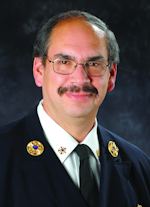Eisner: The Truth, the Whole Truth And Walking on Eggshells
Editor’s Note: The Firehouse staff wanted to share some of long-time Editor in Chief Harvey Eisner’s work. Harvey, a fixture on New York City firegrounds and at major events and conferences since the 1970s, passed away on Oct. 23. He was 59. He has worked with Firehouse since its inception in 1976. He began serving with the Tenafly, N.J., Fire Department in 1975 and served as chief for 12 years.
Recently, I received an email from a reader who asked why we haven’t covered a fire that killed multiple firefighters. You’re probably thinking you know which one it was, but no, it wasn’t that one. Typically, we request permission to cover major incidents such as fires, natural disasters and multiple firefighter fatalities. But no permission, no story, and it’s usually because litigation is involved.
The first fire report, or “On the Job” article, for Firehouse® Magazine was published in 1979. Three years later, a huge fire damaged a super-sized warehouse to the tune of $100 million. The fire chiefs on scene called our office and alerted us to the magnitude of the incident. I drove to the scene four days into the seven-day operation to get the details. On occasion, I’ve spoken with chiefs who operated at major airplane crashes and who shared all the facts. During one conversation regarding a fire involving a jet, however, the chief abruptly hung up on me after he was ordered not to talk anymore.
Over the past 35 years, many of the agencies “with initials” were allowed or invited to participate in post-fire investigations because of their combined expertise. All firefighters want to know what happened, how the incident was handled, how problems were overcome and what lessons were learned. That’s where we have excelled, but we have to wait for the right time. (One significant and newsworthy fire killed 100 people, but I am still waiting for permission to cover the incident.)
Lawsuits have always been around. Today, they seem part of nearly every incident. Lawyers for fire departments, families and others involved have hampered our ability to cover many incidents. You hear about the basic operations and then it is hush-hush.
While I was covering a major incident, one investigator, a friend, was being informed about X by a top official while I heard about Y from others. The fire doesn’t simply burn up and the building burns down; there are always other factors. There were questions about what happened at this fire. Was there a delay in responding? Was there a command error, a tactics problem or was it one or more of a hundred other reasons why things didn’t go right. A lot can go right or wrong on the fireground or at other types of emergencies. Disastrous fires, explosions and firefighter deaths continue to occur. Only the names and places change.
Today, everything is looked at under a microscope when something goes wrong. Fire departments, cities and towns don’t want to look bad and firefighters who operated at the scene don’t want some of these facts to come out if they are ugly to avoid further upsetting families who have lost loved ones. That’s why information is withheld and other people walk on eggshells.
Ten years ago, I attended an initial summit in Tampa, FL, out of which 16 firefighter life-safety initiatives were developed. Last month, I returned to Tampa, where the National Fallen Firefighters Foundation (NFFF) was holding a summit called “Tampa 2” to revisit all that has been done since the last summit on several levels and report on initiatives to continue the important work to reduce firefighter fatalities. With proper training and safety programs developed by the NFFF and others, we can prevent at least some line-of-duty deaths.
During a Firehouse Expo conference, I asked a fire commissioner if he would send a representative of his department to the conference to discuss recent multiple firefighter fatalities. He allowed us to present the program, although two chiefs from that department told me not to have the program. After the presentation, they both came to me and said the program was well done, educational, well received and necessary.
All we can do is strive to present the latest information to keep firefighters alive. Please share information from major incidents. We started “Close Calls” so firefighters could learn from others. We initially kept the locations of the incidents confidential, but now chiefs call us to say they want to provide information so other departments can learn from their close calls. We do all we can do to share information when the time is right.
FOR COMMENTS AND SUGGESTIONS, please contact us at [email protected].
24
2014 firefighter line-of-duty deaths at press time.
743
2014 residential fire fatalities at press time.

Harvey Eisner | Editor Emeritus
HARVEY EISNER was named Editor Emeritus of Firehouse® after serving 15 years as Firehouse's Editor-in-Chief. He joined the Tenafly, NJ, Fire Department in 1975 and served as chief of department for 12 years. He was a firefighter in the Stillwater, OK, Fire Department for three years while attending Oklahoma State University. Eisner was an honorary assistant chief of the FDNY and program director for the Firehouse Expo, Firehouse World and Firehouse Central conferences. He covered many major fires and disasters and interviewed numerous fire service leaders for Firehouse®





